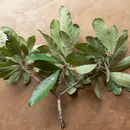Description
provided by Flora of Zimbabwe
Shrub or small to medium-sized tree. Bark grey-brown to blackish, rough in older specimens; stem often fluted; milky latex present. Leaves oblanceolate to narrowly obovate, 9-25 cm long, leathery, glossy green and hairless above, pale with silvery hairs and distinct, parallel lateral veins below, midrib grooved. Young leaves and twigs covered in short brown hairs. Flowers in few to many-flowered clusters on dwarf spur branchlets along the branches, greenish to creamy-white, sweetly scented. Fruit thinly fleshy, ellipsoid, c. 2.5 × 1.5 cm, yellow to orange when ripe, tipped by the style and cupped in the calyx lobes, edible.
- license
- cc-by-nc
- copyright
- Mark Hyde, Bart Wursten and Petra Ballings
- bibliographic citation
- Hyde, M.A., Wursten, B.T. and Ballings, P. (2002-2014). Synsepalum brevipes (Baker f.) T.D. Penn. Flora of Zimbabwe website. Accessed 28 August 2014 at http://www.zimbabweflora.co.zw/speciesdata/species.php?species_id=143720
- author
- Mark Hyde
- author
- Bart Wursten
- author
- Petra Ballings
Worldwide distribution
provided by Flora of Zimbabwe
Widespread in tropical Africa to Mozambique and Zimbabwe.
- license
- cc-by-nc
- copyright
- Mark Hyde, Bart Wursten and Petra Ballings
- bibliographic citation
- Hyde, M.A., Wursten, B.T. and Ballings, P. (2002-2014). Synsepalum brevipes (Baker f.) T.D. Penn. Flora of Zimbabwe website. Accessed 28 August 2014 at http://www.zimbabweflora.co.zw/speciesdata/species.php?species_id=143720
- author
- Mark Hyde
- author
- Bart Wursten
- author
- Petra Ballings
Synsepalum brevipes: Brief Summary
provided by wikipedia EN
Synsepalum brevipes is a shrub or medium-sized to large tree in the family Sapotaceae, that is native to the African tropics and subtropics.
- license
- cc-by-sa-3.0
- copyright
- Wikipedia authors and editors

